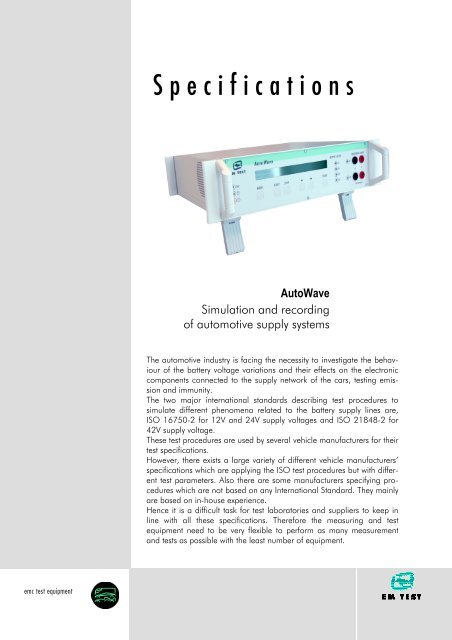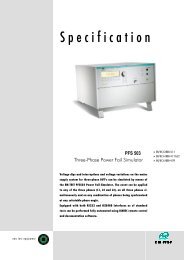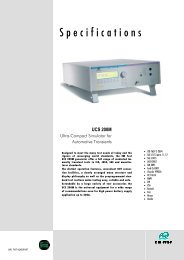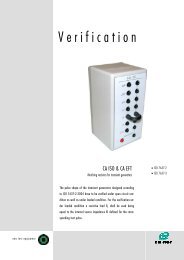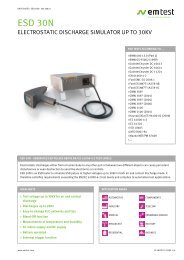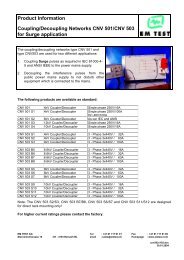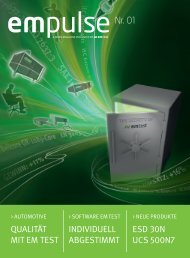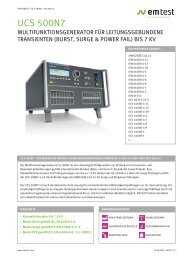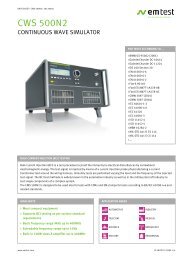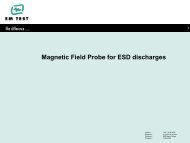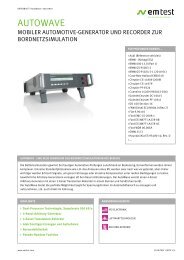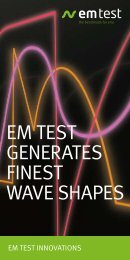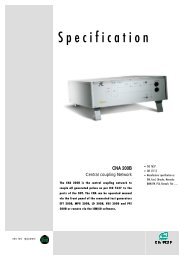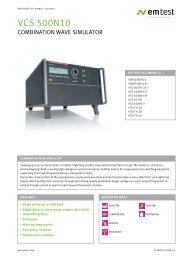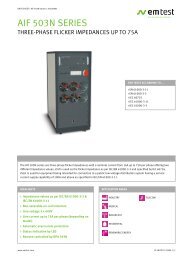AutoWave - EM Test
AutoWave - EM Test
AutoWave - EM Test
Create successful ePaper yourself
Turn your PDF publications into a flip-book with our unique Google optimized e-Paper software.
emc test equipment<br />
Specifications<br />
<strong>AutoWave</strong><br />
Simulation and recording<br />
of automotive supply systems<br />
The automotive industry is facing the necessity to investigate the behaviour<br />
of the battery voltage variations and their effects on the electronic<br />
components connected to the supply network of the cars, testing emission<br />
and immunity.<br />
The two major international standards describing test procedures to<br />
simulate different phenomena related to the battery supply lines are,<br />
ISO 16750-2 for 12V and 24V supply voltages and ISO 21848-2 for<br />
42V supply voltage.<br />
These test procedures are used by several vehicle manufacturers for their<br />
test specifications.<br />
However, there exists a large variety of different vehicle manufacturers’<br />
specifications which are applying the ISO test procedures but with different<br />
test parameters. Also there are some manufacturers specifying procedures<br />
which are not based on any International Standard. They mainly<br />
are based on in-house experience.<br />
Hence it is a difficult task for test laboratories and suppliers to keep in<br />
line with all these specifications. Therefore the measuring and test<br />
equipment need to be very flexible to perform as many measurement<br />
and tests as possible with the least number of equipment.<br />
<strong>EM</strong> TEST AG Tel: +41 (0)61 717 91 91<br />
Sternenhofstr. 15 Fax: +41 (0)61 717 91 99<br />
CH-4153 Reinach
<strong>AutoWave</strong><br />
Introduction:<br />
The new <strong>AutoWave</strong> of <strong>EM</strong> TEST is the appropriate instrument allowing<br />
to simulate all kind of voltage profiles to test the immunity of<br />
the connected electronic components and to investigate the voltage<br />
variations in the battery supply system of a vehicle using an adequate<br />
DC source.<br />
The Architecture of <strong>AutoWave</strong>:<br />
<strong>AutoWave</strong> is based on Dual Processor Technology, using an integrated<br />
high power computer, a DSP and a data storage media (hard<br />
disk or flash drive). Thus is capable to work in real time for recording<br />
an generating waveforms.<br />
<strong>AutoWave</strong> can be controlled either via a GPIB or Ethernet interface.<br />
The Ethernet interface allows fast up- and download of data files.<br />
The USB plug allows also the data exchange with an USB stick<br />
(import of plot files, export of measurement data etc.).<br />
A CAN bus interface is provided for trigger purposes.<br />
The benefits of <strong>AutoWave</strong>:<br />
- 4-channel arbitrary generator<br />
- 2-channel transient wave recorder<br />
- Sophisticated wizard for wave form generation<br />
- Configurable trigger and DUT monitoring features<br />
- Library containing latest standards versions<br />
- Powerful graphics interface<br />
- Multiple interfaces<br />
- Large memory capacity<br />
- Wide-range supply voltage input<br />
The functions of <strong>AutoWave</strong>:<br />
The main functions of this versatile test and measuring instrument<br />
are:<br />
WaveGenerator<br />
Easy generation of waveforms as per many automotive standards.<br />
Generation of all kinds of voltage profile via software<br />
Replay of imported data or plot files<br />
WaveRecorder<br />
Recording of voltage variations and replay of measured data via an<br />
adequate dc source or amplifier<br />
Evaluation of a DUT under real world conditions.<br />
<strong>AutoWave</strong>Control software. Export of measured data to other analysing<br />
programs such as “MathLab”.<br />
WaveGenerator:<br />
The WaveGenerator does much more than a simple arbitrary generator<br />
as available on the market for common use can do. It is specifically<br />
designed for generating all kinds of wave shapes such as<br />
voltage profiles, cranking waveforms and many more covering the<br />
requirements of the automotive industry.<br />
In its basic configuration the WaveGenerator is equipped with two<br />
output channel. This can be expanded by another two channels for<br />
test requirements such as Ford ES-XW7T-1A278 AC, CI230 requiring<br />
the application of up to four wave forms simultaneously. Each channel<br />
has an output range of 10V with 16bit resolution and a frequency<br />
range from DC up to 50kHz.<br />
The WaveGenerator is controlled by the most versatile and userfriendly<br />
<strong>AutoWave</strong>Control software providing the abilities to<br />
- generate any wave form by linking various segments like<br />
DC level, sine wave, sine wave sweep, square wave, triangular<br />
wave, ramp, exponential wave shape, dips etc..<br />
- create wave forms from segments based on mathematical<br />
formulas.<br />
- define wave forms based on point to point data.<br />
- import any plot file from an external measuring instrument.<br />
Using the new WaveGenerator complex and highly sophisticated<br />
wave forms can easily be programmed in a single step with the<br />
<strong>AutoWave</strong>Control software package.<br />
<strong>AutoWave</strong>Control for WaveGenerator:<br />
<strong>AutoWave</strong>Control software for WaveGenerator incorporates a<br />
library of standards including international standards and a number of<br />
manufacturer specifications, updated to the latest state.<br />
The basic <strong>AutoWave</strong>Control software includes the following functions:<br />
- Download of pre-programmed standard test routines from the<br />
software into <strong>AutoWave</strong>.<br />
- Generation of artificial waveforms by graphical or mathematical<br />
tools.<br />
- Management of data files.<br />
<strong>EM</strong> TEST AG Tel: +41 (0)61 717 91 91<br />
Sternenhofstr. 15 Fax: +41 (0)61 717 91 99 autowavev110.doc<br />
CH-4153 Reinach email: sales@emtest.ch 26.09.06<br />
Switzerland URL http://www.emtest.com Page 2/4
<strong>AutoWave</strong><br />
WaveRecorder:<br />
Apart from the traditional transient pulses and voltage variation tests<br />
car manufacturers and their suppliers more and more need to take<br />
care about phenomenon that occur on the supply system when all<br />
subassemblies and components are installed and connected to the<br />
real wiring harness.<br />
The WaveRecorder allows to investigate the effects of subassemblies<br />
and components connected to the battery supply voltage of a<br />
vehicle. Voltages (up to 200Vpp) and currents (via current clamp)<br />
can be measured on two channels simultaneously.<br />
Based on its outstanding technical design the WaveRecorder is<br />
specifically adapted to the requirements of the automotive industry.<br />
Features:<br />
- The built-in storage media (hard disk) allows measurements of up<br />
to 48h depending on the selected sampling rate of 5Hz – 500 kHz.<br />
- The recorded and the generated wave shapes as well as imported<br />
plot files can be reproduced on 4 channels simultaneously.<br />
- The manual operating mode allows to record and replay voltage<br />
profile characteristics to simulate real operating conditions.<br />
<strong>AutoWave</strong>Control for WaveRecorder:<br />
The advanced <strong>AutoWave</strong>Control software for WaveRecorder includes<br />
the following functions:<br />
- Management of data files.<br />
- Record and replay functions.<br />
- Export of measured data to other analysing tools such as<br />
“MathLab”.<br />
<strong>EM</strong> TEST AG Tel: +41 (0)61 717 91 91<br />
Sternenhofstr. 15 Fax: +41 (0)61 717 91 99 autowavev110.doc<br />
CH-4153 Reinach email: sales@emtest.ch 26.09.06<br />
Switzerland URL http://www.emtest.com Page 3/4
Technical Data<br />
<strong>AutoWave</strong><br />
Number of output<br />
channels<br />
Output voltage 10V,<br />
unipolar or bipolar<br />
Resolution 16 Bit<br />
Frequency range DC ... 50kHz<br />
2 channels;<br />
2 additional channels can be added as<br />
an option (ExtBoard)<br />
Wave Forms<br />
Segment types DC voltage<br />
Sine wave<br />
Sine wave sweep<br />
Square wave<br />
Triangular wave<br />
Saw-tooth wave<br />
Ramp up / Ramp down<br />
Exponential wave<br />
Segment duration Unlimited<br />
Number of segments 100<br />
per wave form<br />
WaveRecorder<br />
Number of input<br />
channels<br />
2 channels<br />
( ExtBoard for <strong>AutoWave</strong> required )<br />
Input voltage ranges 5V, 10V, 20V, 50V and 100V;<br />
unipolar or bipolar<br />
Resolution 16 Bit<br />
Accuracy better than 0.2%<br />
Frequency range DC ... 50kHz<br />
Sampling rate<br />
5Hz ... 500kHz<br />
(selectable)<br />
Memory Capacity Min. 40GB on hard disk;<br />
File size max. 1GB<br />
Display and Controls<br />
Display Text LCD 2 lines, 40 characters<br />
LED indicators Power On<br />
Active channel 6 ( 2 inputs, 4 outputs )<br />
Trigger<br />
Functional status hard disk<br />
Operation 6 function keys<br />
Trigger and DUT Monitoring<br />
Trigger 2 inputs, 2 outputs<br />
DUT monitoring 2 inputs, configurable<br />
Interfaces<br />
GPIB<br />
Ethernet<br />
USB (for memory stick)<br />
CAN bus (for trigger)<br />
Frame bus (internal system bus)<br />
General Data<br />
Temperature 0...40°C<br />
Humidity 10%...90% non-condensing<br />
Power supply AC: 90V ... 250V , 47Hz...63Hz<br />
Fuses AC: 1A slow blow<br />
Power requirement 40W max.<br />
Dimension 100 x 380 x 390 mm<br />
Weight 6kg<br />
Technical data subject to change without notice.<br />
<strong>EM</strong> TEST AG Tel: +41 (0)61 717 91 91<br />
Sternenhofstr. 15 Fax: +41 (0)61 717 91 99 autowavev110.doc<br />
CH-4153 Reinach email: sales@emtest.ch 26.09.06<br />
Switzerland URL http://www.emtest.com Page 4/4


